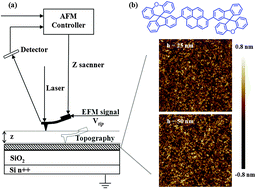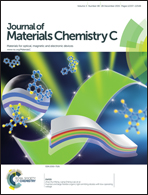Charge trapping behavior visualization of dumbbell-shaped DSFXPY via electrical force microscopy
Abstract
The electrons and holes are injected into the sterically hindered organic semiconductor film (DSFXPY, 1,6-di(spiro[fluorene-9,90-xanthene]-2-yl)pyrene) through applying controllable biases on the conductive atomic force microscopy tip. The scanned visualized images of trapped charge spots in films depend on such factors as decay time after injection, injection biases, and scanning biases with the use of electrostatic force microscopy (EFM). Using the quantitative analysis, the total amount of trapped charges and the surface trapped charge density of the DSFXPY films are calculated and the injected charge signs are confirmed. The results exhibit that the injected charge carriers are highly localized in DSFXPY films, and the retention ability of the holes is stronger than that of the electrons. It is proved that the holes have better endurance in DSFXPY films than electrons by the microscopic experiments. Combining with the evolution processes of trapped charge spots in the different thickness DSFXPY films via Kelvin probe force microscopy (KPFM), the diffusion mechanism of trapped charges is discussed. The results show the application potential of DSFXPY in nonvolatile memory devices due to its outstanding charge storage properties.


 Please wait while we load your content...
Please wait while we load your content...